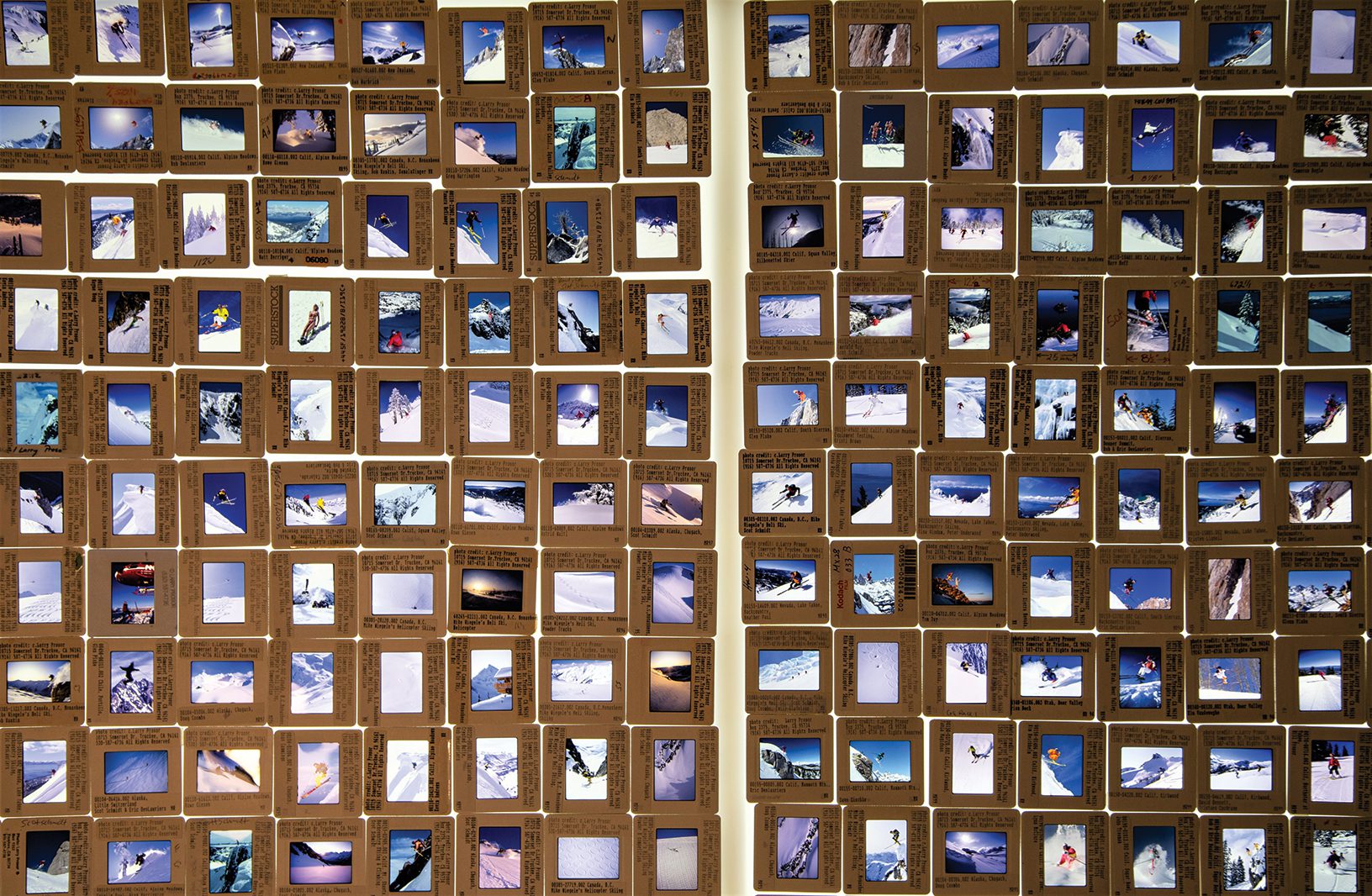
27 Nov Legends of the Lens
Long before digital cameras, a group of photographer friends carved out a niche documenting the top skiing talents of the era on Tahoe’s slopes
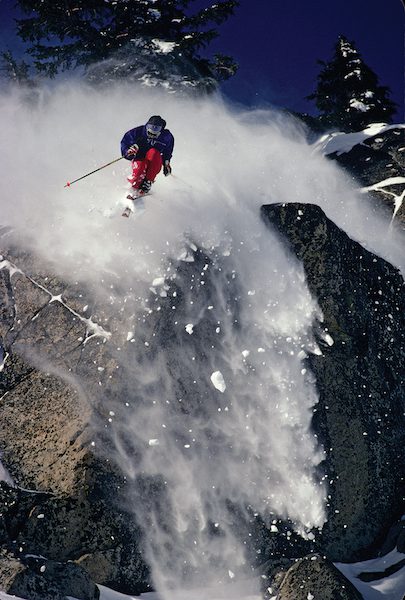
John Treman regularly appeared in magazines, often jumping off large cliffs, photo by Hank deVre
When Hank deVre tucks a camera inside his ski jacket this winter and hits the slopes, it will mark his 50th season of shooting Tahoe ski photos. It’s a journey he could hardly have imagined when, on a lark, he took a fall camping trip here in 1972 and basically never left. He and his brother Raymond camped in Blackwood Canyon that fall until their tent froze over, then moved into a small cabin in Tahoma, where, as luck would have it, deVre’s future wife Meg moved in next door. Talk about good timing!
Good timing has long been a Hank deVre asset, as in choosing the right time to click a camera shutter on a ski slope (with the right people at the right place). The timing of his spontaneous move to Tahoe would also be fortuitous. A new era of ski photography was just dawning, with Powder Magazine’s first issue coming out that same 1972-73 winter. deVre was soon determined to do two things: learn how to ski; learn how to take ski photos.
The brothers both got jobs at Tahoe Ski Bowl (then Homewood), and deVre started shooting photos of the owner’s “hot dog skier” son and others, including—as he learned how to ski—his brother Raymond. Tahoe Ski Bowl began using deVre’s photos in their publicity.
“People liked the photos,” says deVre, “and I figured that photography could be my meal ticket to pay for skiing. We certainly didn’t have the money to go skiing.”
The ski photography “profession” seemed to offer little more than that in the 1970s, its practitioners mostly hobbyists willing to sacrifice some of their quality ski time to strap on a backpack carrying the bulky photography gear of the day, plus film rolls and multiple lenses, to bring possible glory to their friends and little, if any, money to them.
But the first issues of Powder seemed to promise more, featuring the work of a handful of photographers elevating the form in locations like Sun Valley, Snowbird and Switzerland. The ’70s was also a decade of Warren Miller films and the opening of new ski resorts around the western U.S., all of which inspired a new generation of ski photographers, including deVre and three who would soon join him as longtime Tahoe residents and future members of the North Shore “Snow Tribe,” including myself, Larry Prosor and Deacon Chapin.
The Making of a Tribe
Larry Prosor moved to Tahoe’s West Shore the winter of 1974-75, “taking a break from school to sort out life.” He landed a gig as caretaker for a Chico State Ski Club vacation rental and skied 110 days. That first season, a friend sold him a top-of-the-line Canon 35mm camera with three good lenses, and he immediately caught the photography bug.
“I was an apprentice drywall taper at the time, so it was no contest as to what I’d rather do to generate income,” says Prosor.
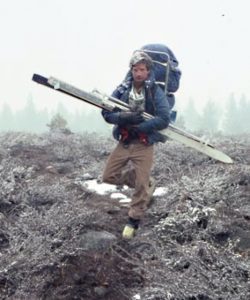
Deacon Chapin, courtesy photo
Deacon Chapin was an early hire at Rolling Stone magazine and one of its chief photographers. But when the magazine made the move from San Francisco to New York in 1977, he and his wife Catherine decided Tahoma was the place to raise a family. While still shooting commercially for Rolling Stone, People and other clients, Chapin began tucking smaller cameras inside his jacket and bringing his unique eye to Tahoe’s ski slopes and backcountry.
My first winters in Tahoe were 1974-76, when, like Prosor, I also took a break from school, caretook at a ski rental for Chico State students and skied five days a week. I didn’t settle in Tahoe permanently until 1979, however, after discovering a passion for photography while traveling through Europe and Asia and publishing a few images with my travel articles. I figured the quest to become a ski photographer would be a struggle, but there seemed no better place to struggle than Tahoe (as long as I could afford a ski pass!).
deVre, Prosor and I would soon be embraced by the generous, creative spirit of Chapin, a mentor to each of us.
The Chapins had built a large home in the far southwest corner of Tahoma and therefore lived near the deVres, who had married in 1978. The couples connected when Meg and Catherine were both pregnant with their first children. Around the same time, Chapin hired Prosor to create drywall “infinity corners” for his in-house portrait studio; Chapin and I met at a local arts event. Soon, the Chapins were having us all over for dinner—and the most exciting slideshows of our young lives.
“Those evenings were an amazing experience, above and beyond the slides, literally,” says deVre.
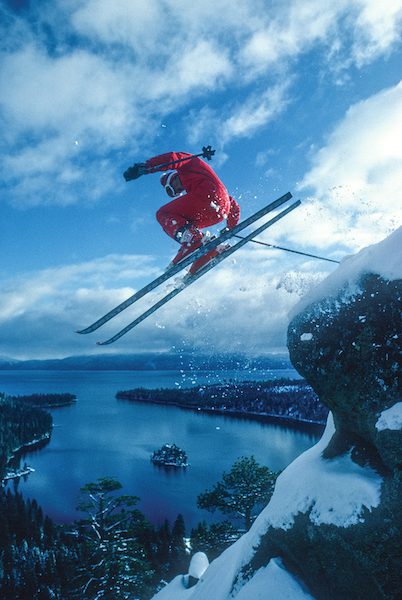
Scot Schmidt above Emerald Bay in January 1985, photo by Larry Prosor
Slideshow Tradition
The Chapins’ “great room” had a 25-foot-plus-high ceiling, and at its peak Chapin attached a long rope swing, allowing him to fly across the entire space, pushing off the walls until he swung so high that his feet touched the ceiling. He was Peter Pan—“Off the wall,” says deVre, laughing. “Deacon was a wild man.”
But he was also a gifted artist and teacher. “We’d all show our reels with our best slides,” deVre remembers, “and then Deacon would put his reel on the projector and—boom!—we’d all go, ‘How did he get shadow and light to form such amazing compositions?’”
“My memories of the mutual slideshows were that each reel had pictures that told a thousand words,” Prosor says. “It was very clear that we had different takes on how to see the world through a lens and our travels to get the photo. But after seeing our group photography … my inspirational vibes were fueled up to keep shooting and skiing at Tahoe.”
The four of us, plus mates, would meet, eat, laugh and show a reel of new work every few months during the early ’80s, usually at the Chapins, but with others hosting at times. Each evening was a delight, but certain ones stand out: Chapin’s unveiling of his incredible “Heart of the Yuba” images; Prosor showing us his first morning shoot with Scot Schmidt at Emerald Bay.
“I thought Larry set the bar higher with those images at Emerald Bay with Scot,” deVre says. “It’s funny to think that when one of them was published in a national ski magazine, they captioned it ‘Backside of Squaw Valley.’”
My memories are that deVre’s photography was consistently strong, due in part to the technical expertise he gained prior to moving to the West Coast, assisting famed New York studio and architectural photographer Lionel Freedman. Photography was also in his blood; deVre’s father was a photographer in Holland prior to moving his large family to the U.S.

Dan Herby skis Light Towers at Palisades Tahoe, circa 1983, photo by Larry Prosor
“When we moved to America, we took a boat across the Atlantic in January. The ocean was ferocious the whole time. All the adults are throwing up, but my dad was out on the bow taking photos of the waves crashing over the boat. I thought that was really fricking cool! Capturing action and freezing it for an instant, that’s what attracted me to photography,” says deVre.
In the different age of the ’80s, national ski magazines had huge followings, and as our photos appeared more frequently, we took some of the energy from our slideshows public. deVre and our fellow Snow Tribe member, writer Robert “Fro” Frohlich, created an “In the Mood” fundraiser and slideshow, which included the work of many other area photographers. deVre and I frantically loaded the slide trays before the show.
Every fall for 13 years, the admission-free shows filled Olympic Valley venues with overflowing crowds, raising thousands of dollars for the North Tahoe High School ski team through a raffle of donated equipment and ski passes.
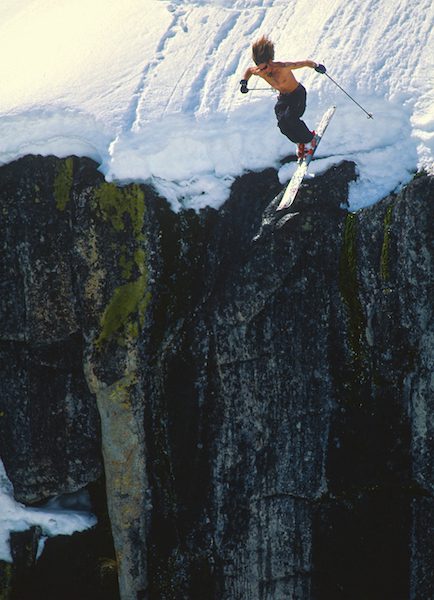
A shirtless Jeff McKittrick sends it off a cliff in the Tahoe backcountry, photo by Hank deVre
Shooting for a Living
We four continued to meet for slideshows into the mid-80s, but less frequently. The era of sharing our early photographic discoveries couldn’t last, sadly. Prosor, deVre and I were all now publishing more photos and gathering clients. More and more, “It seemed like we were all going for essentially the same thing,” says deVre.
Nevertheless, on our last evening slideshow together, I proposed we start a photo stock agency, modeled on a partnership that had popped up in Aspen among its resident photographers. Prosor was just about to launch his successful postcard and photobook company, and Chapin was becoming more involved in teaching, eventually becoming a photography instructor at Sierra Nevada College in Incline Village.
But the stock photo licensing idea made sense to deVre and me, so with the help of Meg and my assistant, Simone Gerstner, we formed Mountain Stock Photography, an enterprise that would eventually represent 85 photographers from around the world during its 15-year run, including Tahoe locals like Bud Fawcett, John Clausen, Tom Zikas and Kurt Molnar.
Mountain Stock helped expand the reach of Tahoe ski imagery into national and international media, as did Prosor’s work with Schmidt and other skiers. deVre and I were named to Powder’s list of “World’s Top Ski Photographers” in 1988, and along with Prosor, we were bringing more photo shoots to Tahoe. Essential to our success were the partnerships we formed with Tahoe’s gifted local athletes and, increasingly, top skiers and snowboarders from around the country who visited or moved here to film with still and motion photographers.
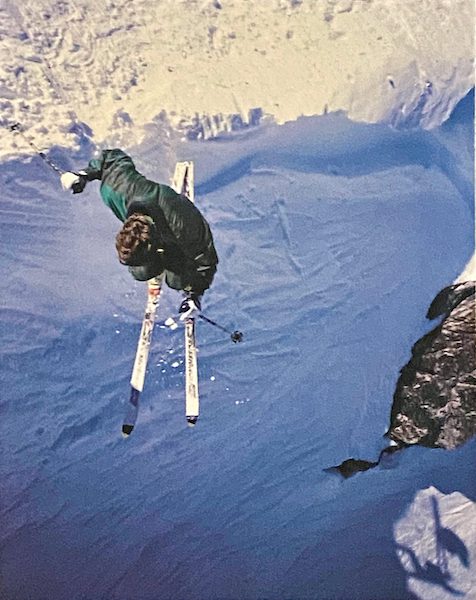
John Treman in Powder Magazine’s 1994 Photo Annual, pictured using the suspended “pole-cam” technique developed by Chaco Mohler, photo by Chaco Mohler
One Montana skier who moved here was Scot Schmidt. “When Scot and I first met, he was wearing Squaw Valley Ski Team training sweats,” says Prosor of his seminal partnership with the “extreme ski” pioneer. “The first shoot we did together went great. Scot had his own style on skis and was comfortable in steep terrain and in the air. He was pushing personal limits but had a safe-smart approach to planning our shots.”
The first big break for both was a multipage photo feature in Powder, which led to work with Warren Miller films.
North Tahoe would become a beehive of still and motion ski photography most every sunny winter day, many of us working with the same top talent pool: Kristin Lignal, Astrid Walti, Peter Underwood, Kevin Andrews, Tom Day (before becoming a cinematographer) and out-of-towners who spent weeks or whole winters in Tahoe, like Dan and John Egan, Kristin Ulmer, Lynne Weiland, and Rob and Eric DesLauriers (the latter becoming a Tahoe local).
Underwood accompanied me on numerous travel assignments for Skiing Magazine, including to Europe and South America. I had a Powder cover with him, as did photographer Rod Bruner. Including his additional appearances in photos by Prosor, deVre and others, Underwood (now co-owner of Tahoe City’s Olympic Bike Shop) was arguably the most published skier in the world for at least a year or two.
deVre formed fruitful partnerships with many current and future ski stars. His brother Raymond had become a freestyle ski coach at Squaw Valley and introduced him to Brad Holmes. “He was a phenom as a skier, just magical,” says deVre. “We traveled to a lot of different places to shoot,” many of the images ending up in Powder and elsewhere. Holmes is now a cinematographer for Teton Gravity Research (TGR).
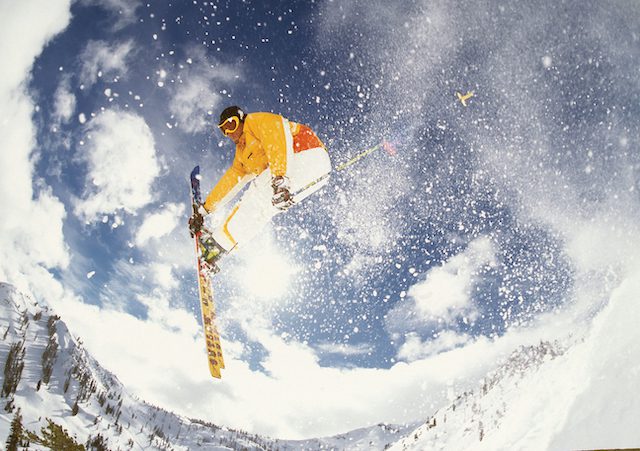
Brad Holmes at Palisades Tahoe in 1998, photo by Hank deVre
“I met Jonny Moseley when he was just a small kid,” says deVre of the future Olympic champion. “I shot with him and his family and little Jonny went speeding out front and did this perfect turn. That photo ended up being the cover of the Squaw Valley Trail Map the next season.” It was the first but not last cover that Moseley and deVre would team up on.
Meanwhile, John Treman and deVre also formed one of the most productive, long-lasting partnerships in the ski world. “John and I had a big rally together for seven or eight years,” deVre says. “I worked almost exclusively with him for a few winters.” Photos of Treman’s increasingly huge cliff jumps made appearances in Powder issue after issue.
Powder’s editor at the time, Steve Casimiro, published a piece on deVre that praised his work as being the top of the art form. “That sent me to the next level,” deVre says. In addition to work for other magazines, deVre began shooting stills on multiple films. At the same time, his summer gig, Blacktop Sealing Company, freed him from reliance on pure revenue during the winter months and allowed him to tackle projects close to his heart.
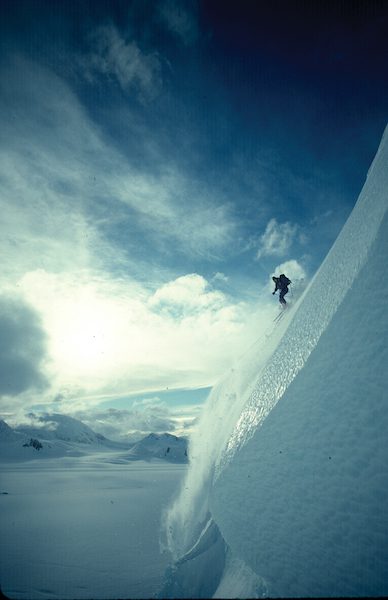
Mike Farny on a Warren Miller expedition to the Antarctic Peninsula, circa 1989, photo by Chaco Mohler
‘The Wrong Direction’
The ’90s began a shift in ski culture that was a challenge to ski photographers accustomed to “working with our friends to shoot photos and have fun,” says deVre. “The magazines started to tell us who we had to shoot with. Powder went from being the skier’s magazine to the sponsored skier’s magazine.”
Some athletes also felt pressure to push the envelope in their chase for fame. We “old-school” ski photographers, who had always emphasized safety on the mountain, were faced with hard decisions.
“I’ve walked away from film shoots where I thought the athletes were getting pushed into a dangerous situation,” deVre says. He declined to shoot Treman’s 160-foot cliff jump on Donner Summit, and he and I both declined to shoot Paul Ruff’s attempt at a world-record cliff jump near Kirkwood in 1993, which ended tragically.
“Then parachutes started coming out, and I thought things were going in the wrong direction,” deVre says. “I was shooting stills with Shane McConkey on a TGR film, and he was planning a double flip off a cliff with only seconds to throw the chute. I expressed concern as he walked up the mountain past me, and he said, ‘What’s the matter, Hank, don’t you want to shoot my demise?’”
After a quarter century “at it,” my “aha” hint of an era ending concerned another factor, however. I had been shooting all day with K2 Ski athletes on helicopter drops in Alaska and was trying to elevate out of the powder on our last run home at dusk when my dear friend Kim Reichhelm said, “Chaco, you’re skiing like shit!”
Modern cameras with autofocus and auto-bracketing had already made the ski photography craft more accessible. Digital was on the horizon and, soon after, the iPhone.
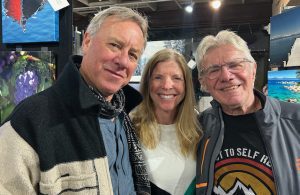
Chaco Mohler, left, Kristin Lignal and Hank deVre, courtesy photo
Passing the Torch
The Prosors moved out of the area to a tropic beach in New Zealand and I gave up professional photography in 2000, in part to help start this magazine. Our generation of the Snow Tribe would also soon suffer two heartbreaking losses. Deacon Chapin died in an accident in 2001, and Robert Frohlich left us in 2010 after a long battle with cancer.
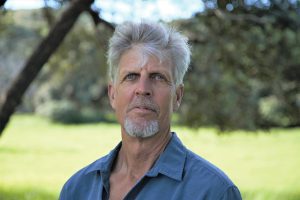
Larry Prosor, courtesy photo
Now a new Snow Tribe of Tahoe photographers and filmmakers carries the torch forward, some of them the leading national talents of the day. Fortunately, one of them is still Hank deVre, an elder statesman at age 75.
“I just can’t quit,” he says. “The outdoors is the studio for me. Being active and working for the shot is what inspires me. We just try to have real beautiful days on the mountain and capture a little blink of action that shows the spirit of skiing, the soul of it. That’s what excites me.”
Chaco Mohler is the former publisher of Tahoe Quarterly and the magazine’s first editor-in-chief.




McH
Posted at 20:51h, 05 DecemberThanks for giving Deek his props. He was half-swallowed by his addictions when I met him, yet still we did cool shit. Summiting Clark is one. Blessings on you all. You did your best to share the mtn dharma.
vbSAND
Posted at 17:57h, 09 JanuaryThough not mentioned, Peter Underwood was maybe the best technical skier of the 1980’s Tahoe extreme set. Multiple magazine covers. Followed him around Squaw chutes all season during the massive snowfall winter of 1982-83. Miss those days!